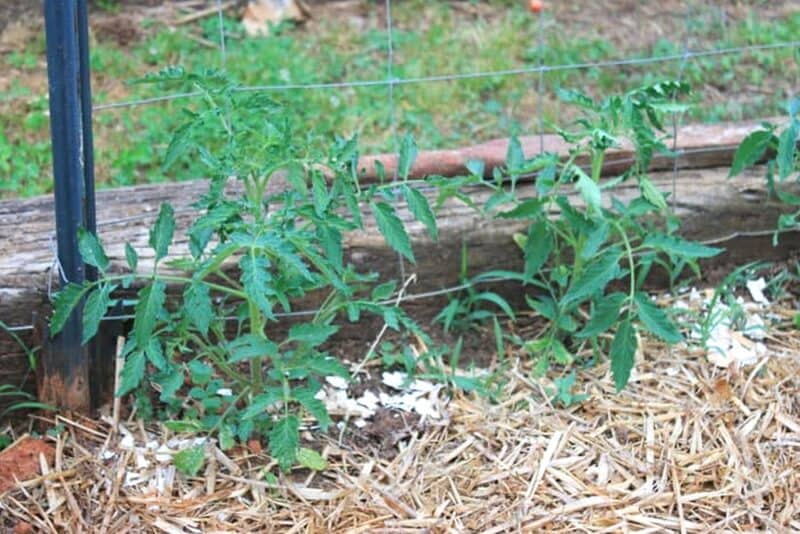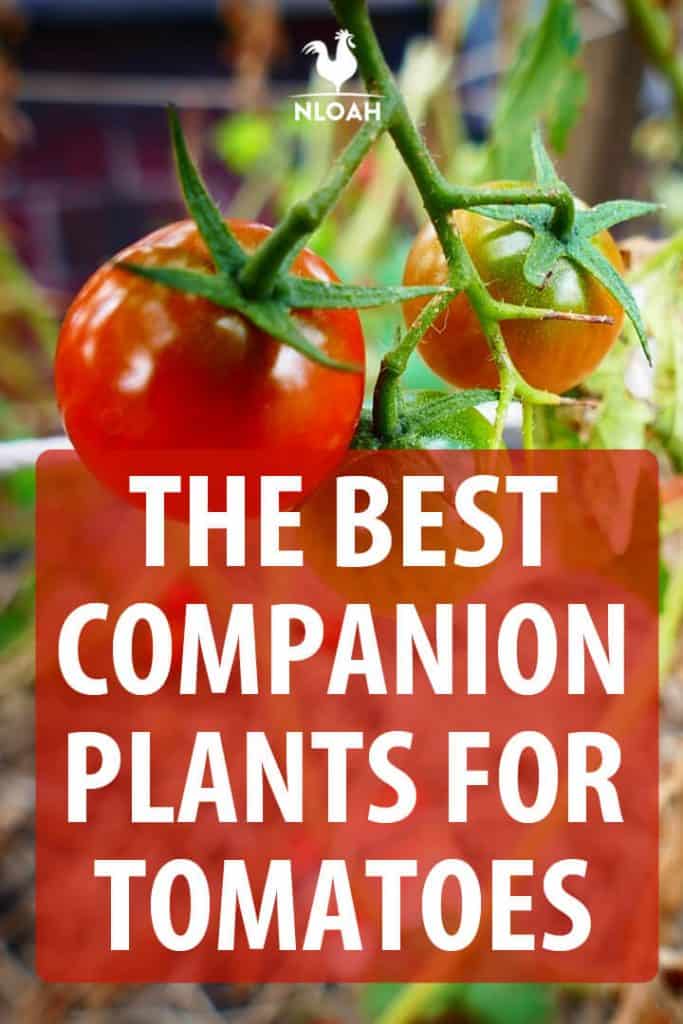Companion planting is one of the best ways to make use of space and improve the health of your tomatoes. Like good friends, companions to tomatoes boost their productivity and ward away negative energies that affect growth.

While some companions keep away pests, others encourage beneficial insects for pollination and their predatory capacities. Equally, some companions boost flavor, while some put necessary minerals into the soil to enhance plant growth and yield.
Tomatoes tend to have a wide range of companions, which interestingly, seem to include a lot of the herbs that we cook with tomatoes – as to the old adage, what goes together grows together.
But how do we go about planting companions for tomatoes and which plants should we choose?
Tomato Requirements For Growth
When we first consider companion planting, we need to ensure that the plants we select don’t interrupt our tomato plants’ requirements for growth.
To get the best from your tomatoes, they need at least 8 hours of full sunlight a day. In this respect, don’t plant anything tall and bushy to the south of your tomatoes as it will block their sun.
Tomatoes also need loose, well-drained soil so planting companions that help to break up the ground will be of huge benefit to your tomatoes.
Tomatoes need continuous, even watering. Ensure you’re not planting water-hungry species right near your tomato plants or they’ll steal the moisture.
Tomatoes need protection from strong winds. While, yes, tomatoes generally need trellising, you should also consider planting something bushy or hardy in the wind paths around your tomatoes to block on-coming gales. Be careful not to block the sunlight, however.
On an additional note, tomatoes need warm, dry weather for at least 3-4 months of the year. On the other hand, if the nighttime temperatures stay above 85F for long periods of time, the tomatoes won’t color properly. In this sense, keep them away from big boulders or rocks that will release thermal mass during the nighttime.
Best Companions For Tomatoes
Companion plants help to boost tomato growth and productivity, improve flavor, deter pests, and improve pollination.
Productivity and Growth Boosters
Basil – Improves the flavor of tomatoes, as well as encouraging bees for better pollination.
Borage – Improves the flavor of the fruits, as well as mining minerals from deep in the ground and depositing them on the topsoil with their leaf drop, encouraging tomato growth.
Nasturtium – While not competing for root space, nasturtium also encourages beneficial pollinators.
Carrots – Carrots break up the soil for tomato roots to slide in easily. Carrots are usually ready just after tomatoes are planted, giving way to good soil without competing for nutrients. See their list of companion plants here.
Young Dill – Young dill encourages tomato plant growth, but be aware that mature dill will inhibit the growth of tomatoes, so harvest early.
Nettles – Nettles take nitrogen from the air and put it in the soil, working as a natural fertilizer for tomatoes. They also improve the taste.
Spinach/Lettuce – Both of these work as a ground cover to prevent soil erosion, while also keeping weeds at bay that may compete for nutrients and root space.
Sow Thistle – Sow thistle uses its big taproot to mine minerals and bring them to the topsoil helping tomato growth and flavor.
Pest Control
Basil – Basil keeps away whitefly, mosquitoes, spider mites, and tomato hornworms.
Borage – Borage is one of the best thing to keep away tomato hornworms.
Chives/Onions – The pungent smell of chives and onions keeps back aphids and flea beetles, whose larvae feed on the tomato roots.
Garlic – Garlic keeps back aphids, as well as warding away red spider mites thanks to its smell.
Mint – Mint keeps ants, aphids, and flea beetles away. Interestingly and annoyingly, rats love to feed on tomatoes, and mint keeps rats away.
Marigolds – Marigolds excrete a strong toxin from their roots which kills nematodes and scares away slugs and tomato hornworms.
Nasturtium – Nasturtium also serves to ward off whitefly, aphids, beetles, and fungal diseases like verticillium wilt and fusarium wilt.
Parsley – Parsley attracts hoverflies who are predators that feed on all kinds of tomato pests.
Asparagus – Asparagus produces a chemical from its roots which kills off nematodes and slows their development.
Which Plants Benefit From Tomatoes?
Tomatoes also serve to help other plants without necessarily gaining direct benefits themselves. Introducing some of these plants increases resilience through intercropping, which helps to prevent the spread of diseases as well as attracting diverse pollinators.
Asparagus – This is a mutual relationship as while asparagus wards off nematodes, tomatoes prevent asparagus beetles.
Gooseberries – The scent of tomatoes repels the pests that prey on gooseberry bushes. Gooseberries can also serve as a good wind block for tomatoes.
Roses – Tomatoes prevent and slow down the spread of black spot in roses when you place a tomato plant in between each rose bush.
Spinach/Lettuce – Tomatoes provide good shade for these plants that can get easily burned up in the sun.
The Worst Companions for Tomatoes
There are some plants that just don’t get on with tomatoes and should never be planted near them, as they leave tomatoes subject to growth stunting or attract tomato pests.
Black walnut – This big tree produces a toxin in its roots called juglone, which inhibits or sometimes even prevents the growth of tomatoes. Its wide canopy will also shade tomatoes.
Corn – Tomatoes and corn are bad for one another as they attract pests that damage each other. Tomatoes attract corn earworm, while corn attracts tomato hornworm.
Brassicas – This includes broccoli, cauliflower, brussel sprouts, kohlrabi, kale, and others. Brassicas inhibit tomato growth.
Mature Dill – Mature dill releases a toxin from its roots which stunts tomato growth.
Fennel – Close to dill, fennel reacts in the same way, stunting tomatoes.
Potatoes – Though they break up the soil, potatoes are also susceptible to the same fungal diseases that tomatoes can get. Placing them nearby only serves to spread these diseases.
Eggplant/Peppers – Anything in the nightshade family is susceptible to verticillium wilt, and planting them all near each other only makes the vulnerable to spreading the disease among themselves. That said, however, peppers do have a chemical in their roots that helps to prevent fusarium wilt.
6 Benefits of Companion Planting Tomatoes
1. Growth Boost
When we companion plant tomatoes, we help to boost their growth in two main ways: by improving the soil and by encouraging pollination. Some companions to tomatoes work by adding nutrients to the soil, such as nitrogen fixers that work as a natural fertilizer, and dynamic accumulators that add minerals to the topsoil.
Moveover, some plants encourage useful insects that help pollination. With higher numbers of beneficial bugs, more tomato flowers get pollinated which leads to a higher yield of fruits.
2. Natural Pest Repellent
Tomatoes are susceptible to a number of pests including tomato hornworms, aphids, and beetles. There are crops and herbs that can be planted near to tomatoes to keep these threats at bay.
Some produce chemicals from their roots that kill off the unwanted bugs, while others attract predatory insects, like hoverflies, which eat tomato pests.
3. Space Saving
When we intercrop plants, we save space by planting in four dimensions – height, width, length, and over time. Some plants use the rhizomatous layer (underground), while some like to crawl along the ground.
Planting these next to tomatoes helps to save space without getting in the way of the sun. Equally, some plants finish just as tomatoes are planted, creating looser soil for the tomatoes, while also saving space.
4. Preventing Soil Erosion
By companion planting, we can prevent soil erosion. Bare soil likes to wash away with the rain or blow away in the wind, leaving tomato roots exposed. By planting complementary partners near the tomatoes, we can hold the soil in place, keeping moisture locked in and preventing erosion.
5. Keeping Back Weeds
Weeds like to grow anywhere they can. Exposed soil is a haven for pesky weeds that compete for root space and nutrients with tomatoes. By planting companions, we leave no room for weeds to sidle on in.
6. Halting Disease
Tomatoes can be subject to various fungal takeovers which cause disease such as verticillium wilt and fusarium wilt. When we plant only tomatoes together, these problems can spread rapidly. By intercropping with companions, we halt the disease in its tracks as it only likes some species of crops and not others.
All in All…
Companion planting tomatoes has a whole bunch of benefits. Not only does it save space, keep weeds at bay, and prevent soil erosion, companion planting also helps to prevent the spread of disease – especially fungal issues that are so prevalent in tomatoes and other members of the nightshade family.
You’ll also find that companion planting will boost tomato yields through high levels of pollination, by attracting beneficial insects, like bees.
Pest control is one of the major reasons for companion planting tomatoes, as aphids, hornworms, and beetles can overtake the garden and gnaw your tomato plants to the ground.
By popping in some nasturtiums and marigolds, you can truly catch the permaculture ethical vibe through multi-purpose elements as these flowers not only keep tomato bugs away, they increase pollination, look beautiful, smell nice, AND are edible!
Don’t hesitate, when you get you tomatoes in the ground, get their friends in alongside them. But remember to keep them away from brassicas, dill, corn and walnuts, or you’ll end up with teeny tiny tomatoes!


Emmy Jenkins, AKA Permie Emmy, has spent many years traveling around the globe and working remotely, dipping her toes into a myriad of disciplines. Having spent several years volunteering on sustainable farms, Emmy chose to delve deeper into permaculture theory to understand the social and economic patterns often neglected in the philosophy. When she’s not planting edible gardens and frolicking the jungle, she’s consulting on projects around the world to help permaculturalists to understand regenerative ‘Fairshare’ economic patterns and to encourage People Care patterns that focus on biomimicry.

Good and timely article. I’ve often heard that potatoes and tomatoes go well with corn but that has NOT been my experience. So, I agree with you that it isn’t a good idea to plant them together. On the other hand, some of the best tomatoes I’ve ever grown were planted in a raised bed full of marigolds that had peas in to previously.